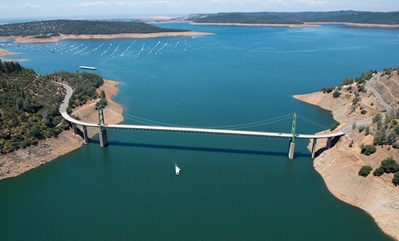Oroville Dam Safety Comprehensive Needs Assessment

Following the 2017 Oroville Spillway Incident, DWR made commitments to the Oroville community, federal and state dam safety regulators, the Federal Energy Regulatory Commission (FERC) and the California Division of Safety of Dams (DSOD), to assess the facilities within the Oroville Dam Complex to identify further dam safety and operational needs. In addition, DWR committed to identifying potential measures to address those needs and reduce dam safety risks. In January 2018, DWR initiated the Oroville Dam Safety Comprehensive Needs Assessment (CNA) and the report published in November 2020.
The CNA process was led by DWR as the owner of the Dam. As part of the process, an Independent Review Board (IRB) of dam safety experts conducted independent technical reviews of key deliverables and documented its review of DWR’s work products. The CNA also included engagement with an Ad Hoc Group of community stakeholders appointed by Senator Jim Nielsen and Assemblymember James Gallagher. The Ad Hoc community group met regularly with DWR and the IRB. The Ad Hoc group provided community perspectives and communicated about the CNA process and findings to the larger Oroville community.
The CNA is the most comprehensive risk analysis that DWR has undertaken for any facility to date. The results show the Oroville Dam Complex is safe to operate, and no urgent repairs are needed. Since conditions can change over time, DWR will conduct ongoing monitoring and assessment to maintain the safety and reliability of the complex.
In addition, the CNA identified several risk-reduction projects that DWR already is moving to implement, including installation of new water pressure measurement devices to improve seepage monitoring and completion of a state-of-the-art seismic stability analysis. DWR is also planning to implement recommendations to raise Parish Camp Saddle Dam by three feet, line Palermo Canal to reduce leakage and improve rock slope stability and install new remote starter and power connections to the spillway radial gates to improve reliability.
In addition, the CNA identified potential vulnerabilities that require further examination to better understand their actual risk.
The CNA final report includes an exhaustive summary of the risk analysis process and findings and includes recommendations for future next steps and future projects which will incorporate community feedback whenever possible while keeping dam safety as the top priority. The final report has been submitted to FERC and DSOD.
The CNA is not meant to investigate the causes of the events during the February of 2017 spillways incident. Likewise, this assessment is not meant to critique operations at the Oroville Dam or place fault or blame to any person or agency involved in the February of 2017 spillways incident.
Independent Review Board
DWR convened an Independent Review Board (IRB) to conduct independent technical reviews of key deliverables and document its review of DWR’s work products. The members of the IRB who participated in the CNA are national experts with diverse technical expertise, experiences and perspectives. Their expertise covers disciplines in geotechnical, hydraulics, structures or hydraulic structures, operations, engineering geology, and environmental resources. Collectively, they have experience with safety and dam design modification of large dams, complex multi-purpose dam safety operations and projects, large government organizations, water policy, environmental science, and stakeholder engagement.
Specifically, the IRB reviewed and assessed:
- Proposed alternatives to restore the spillway design capacity
- Proposed project flood operations associated with various alternatives
- Proposed remedial options for the service spillway headworks
- Proposed low-level outlet alternatives
- Proposed dam embankment reliability and improvements
- Proposed dam complex instrumentation and monitoring plans
The IRB also met with the community leaders serving on an Ad Hoc Group at key junctures to answer their questions, collect their feedback, and revised the CNA when appropriate.
View the IRB Comment and Recommendations Log from Meeting #8.
IRB Members:
Community Ad Hoc Group
Senator Jim Nielsen and Assemblyman James Gallagher appointed a group of community members to represent the community during the CNA. The Ad Hoc Community group’s role was primarily to communicate accurate information and context about elements of the CNA under consideration – and the final document – to the stakeholders and interest groups that they represent. The Ad Hoc Group also provided informed community and stakeholder perspectives to the IRB as the Oroville Dam CNA was developed. The Ad Hoc Group received questions about the CNA from the community and interested parties and communicated relevant questions or concerns to the IRB.
View CNA Ad Hoc Committee Charter
Ad Hoc Community Group Members:
- Assemblymember James Gallagher (Co-Chair)
- Senator Jim Nielsen
- U.S. Representative Doug La Malfa
- Butte County Sheriff Kory Honea
- Butte County Supervisor Bill Connelly
- Matt Mentink
- Ron Stork
- Michael Bessette
- Mark Spannagel
- Genoa Widener
- Sean Earley
- Rune Storesund
Community members can submit questions and comments to the ad-hoc group. If you wish to submit a question or comment, please email: OrovilleDamAdHoc@gmail.com
Contact
Submit your questions or comments to the Oroville CNA IRB and Community Ad Hoc Group:
